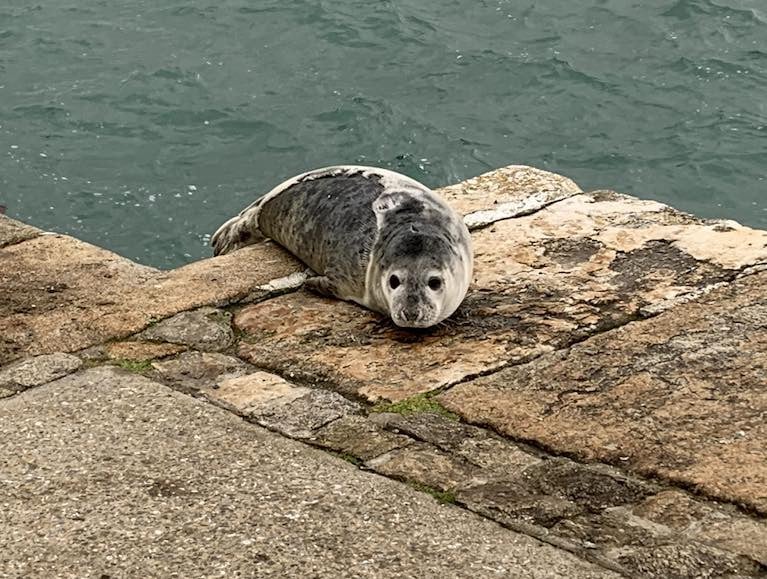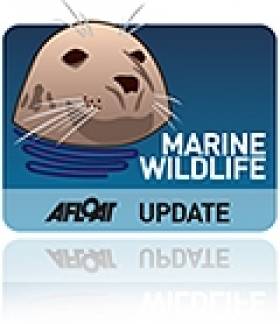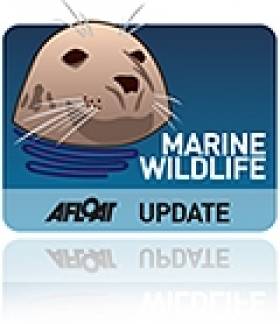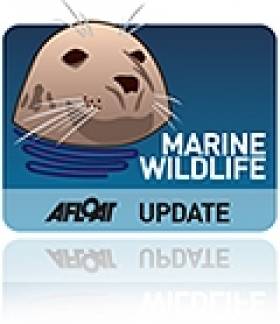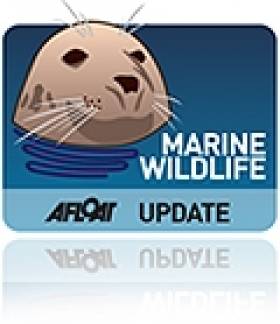Displaying items by tag: Seal
Seal Pup Hauls Out at Dun Laoghaire Harbour
This inquisitive Dublin Bay young seal made his way up the steps of Dun Laoghaire's East Pier much to the surprise of weekend harbour strollers.
Harbour and grey seals have a year-round presence at Dun Laoghaire and Dublin Bay in general.
The seals often haul-out on man-made structures and tolerate considerable human activity but it's unusual to see a pup on its own on the East Pier.
Such sites are used during breeding, moulting, resting between foraging trips in the open sea, and to engage in social activity.
Under the Wildlife Acts 1976 to 2018, cetaceans and seals are protected species.
The Irish Sea Sanctuary says if you encounter seals ashore "the GOLDEN RULE…..is give them space and observe from a distance".
Seals and getting to the truth about shooting them was the subject of a recent podcast by Afloat's Tom MacSweeney here.
Irish Seal Sanctuary Calls for Bull Island Dog Ban
The Irish Seal sanctuary (ISS) is calling on the public to be vigilant and keep dogs away from seals on Bull Island. Bull Island and Dublin Bay is a biosphere reserve unique to the capital city and is home to both species of seals. Despite the strongest protection and designation available in law, breeding seals are subject to daily harrassment and disturbance, mainly by dogs. To date this harrassement has led seals to abandon their pups prematurely and two newborn pups are known to have died so far.
The ISS is calling on Dublin City Council (DCC) and the National Parks and Wildlife Service (NPWS) for an immediate dog ban on Bull Island untill the completion of the seal breeding.
Authorities are promising consultation, signage, trained voluntary guides and dog walking zones. This is all most welcome, however the seals are vulnerable now and if this level of harassment continues may disappear from the island. Several notable species, including terns and hares have already been lost, says ISS spokesman Brendan Price.
Grey Seals, the world's first protected species, residents of Dublin Bay and ubiquitous around the Irish coast are breeding now and during this time are very vulnerable to disturbance. Female seals require quiet shore space and breeding beaches to give birth. Thereafter females nurse their pups ashore for about 3 weeks. This is a period of the seal lifecycle that can only happen on land and while fascinating to watch, the golden rule is to observe from a distance.
Around the Irish coastline, this great wildlife spectacle is enjoyed and progresses undisturbed, however areas such as Bull Island are under increasing pressure from dogs and some walkers.
It is a great tribute to sensitive walkers and dog walkers, who avoid disturbance and some colonies are known to survive close to human habitation. Nevertheless evidence suggests that it only takes a few disturbances to drive seals away.
Bull Island, where the above photo is taken, is an especially sensitive area, unique also as host to both species of Irish seals, hauling out, feeding and breeding within the boundaries of the Capital city.
The Island a UNESCO Biosphere of long standing, now extended to the boundaries of Dublin Bay has sadly already lost breeding colonies of Terns and Hare. Two newborn, whitecoat, pups from island have died within the last month and post mortem analysis at the School of Veterinary Medicine, UCD, suggests abandonment and predation as the cause of death.
The DCC in response to these records is discussing improved signage, zonation, voluntary island guides etc., however in the meantime the seals remain vulnerable, the rangers and island are under resourced and the threat of losing this remarkable colony remains high.
The Bull Island is a stark but not unique case with Bailey and Doldrum Bay, outside Howth, abandoned by seals almost 100 years ago. These areas are still host to occasional pups, and walkers have recently been observed climbing down to a pup to take pictures and in another incident, misguidedly, throwing a pup into the water. Limekiln Bay and Brittas Bay have very vulnerable mothers birthing in the path of walkers and the pattern repeats coastwide.
The common seals, which bred earlier, are less vulnerable to threats from land as pups take to water on tide. Nevertheless, recreational users should be aware of their presence as these pups get separated from mothers by power boats, jet skis etc.
Litter, debris, waste can cause horrific injuries and usually result in death before affected animals can be caught and given veterinary help.
The message for today, according to Price, is do not disturb resting seals and do not create seal orphans (the endearing whitecoats) for rehabilitation when seal mothers can do a far superior job of nursing and rearing.
Lost Seal Being Treated For Pneumonia
#MarineWildlife - The grey seal who surprised Merseyside in the days before Christmas by getting lost in a field some 30km from the Irish Sea is now being treated for pneumonia, as The Guardian reports.
"He is much more settled now and still looks very sorry for himself, but other than that he is quite lively," said Sue Levings of the RSPCA's specialist seal facility in East Winch, Norfolk, where the young seal – named Dumbledore after the Harry Potter wizard – is being looked after.
As previously reported on Afloat.ie, the marine mammal was spotted by a dogwalker in a muddy field at Newton-le-Willows, north of Warrington and far from his species' usual seaside haunts.
Seal Causes A Splash In Freshwater Lake
#MarineWildlife - The Irish Examiner reports that a seal has been spotted some 24km inland from the coast in the lakes of Killarney.
The rare sighting was made near Muckross Abbey last week by angler Mike O'Sullivan, who couldn't believe his eyes when he first spotted the marine mammal.
"People mix up seals and otters," he said. "But when I looked through ... binoculars it was a seal. In all my time on the lake, I never saw a seal.”
It's believed the common or harbour seal migrated to the inland lakes via the River Laune from Castlemaine Harbour.
And it's not the first time a seal has been spotted far from its usual habitat in these islands.
In January it was reported that a seal had travelled more than 80km from the Norfolk coast to the Fen Drayton lakes in Cambridgeshire. The Guardian has video of the intrepid explorer HERE.
Seriously Ill Seal Pup Now In Recovery
#MARINE WILDLIFE - A harbour seal pup found in a serious condition in Balbriggan last week is new recovering in the care of the Irish Seal Sanctuary.
Colin, as he has been named by ISS volunteers, was discovered on Kings Beach suffering from blood loss and breathing problems, the Fingal Independent reports.
An ISS spokesperson remarked that it was "very unusual" to find harbour seal pups this late in the year, and in an area dominated by colonies of grey seals.
Thanks to medicine donated by the Dogs Aid veterinary clinic in north Dublin, Colin is now "making great progress" though full recovery will take some time.
The seal pup will remain in the care of the ISS until he is fit enough to be returned to Balbriggan for release.
Poots Appeals Over Latest NI Seal Deaths
NI environment minister Edwin Poots has appealed to the public for information on marine animals following the suspicious deaths of five seals in Strangford Lough last week.
The grim discovery comes only weeks after a wave of fatal corkscrew-like injuries to seals in the same region.
The UK Department of Environment confirmed to the BBC that one of the seals had similar corkscrew imjuries, while another had been shot.
Minister Poots told BBC News: "Despite warnings from the Northern Ireland Environment Agency in the media, there are still people who have no qualms about carrying out this inhumane practice."
He added: "Now, in the light of the latest deaths, it is even more important that we find out who is behind this and put a stop to it."
Watch Out For Tagged Seals
The Irish Seal Sanctuary (ISS) has put out a call for observers to look out for tagged seals.
Following the news that a seal pup rescued and tagged by the ISS was discovered in Wales, the sanctuary is looking to build a better picture of what becomes of its seals once released back into the wild.
Observers are asked to report on the condition of any seals tagged on a hind flipper with an orange tage (for grey seals) or a yellow tag (for common seals) and with the code A4 written on one side.
The ISS hopes that this information will give a clearer idea of how rescued seals readjust to life in the open water, and how they interact with wild seals or with people in Ireland's harbours.
Any relevant information can be forwarded by e-mail to [email protected] or [email protected]
Irish Seal Sanctuary Receives Surprise Donation
A young supporter of the Irish Seal Sanctuary (ISS) has donated €450 to help the seals she visits regularly.
Staff at the sanctuary in Courtown, Co Wexford were amazed when 13-year-old Sarah Butler donated her personal savings towards the care of stranded or orphaned seal pups.
Sarah and her mother Karen from Wexford town have been frequent visitors to the sanctuary and even adoped its first grey seal of the season, named Debbie.
In recognition of Sarah's incredible generosity, the ISS has awarded her with 'freedom of the sanctuary' and welcomed her to visit any time she wants.
Rescued Seal is Stabbed to Death
Dunmore East Seal Shooter is Fined, Loses Guns
Waterford Circuit Court has upheld the District Court's prosecution of a fisherman for animal cruelty after the shooting of a seal in Dunmore East harbour.
The unnamed shooter – who was formally licensed by the National Parks and Wildlife Service for animal control – was fined €1,000, barred from further licence for 10 years and given a suspended sentence for 'attitude'. He also had his guns confiscated by the court.
The case followed from an incident in February 2007, when a bull grey seal in Dunmore East harbour was shot at close range and left to die, apparently in full view of tourists and other onlookers.
Grey seals are a protected species under the Wildlife Act 1976, but are often considered a pest within fishing communities.
Brendan Price, director of the Irish Seal Sanctuary, commented after the verdict: "The judge sent out a timely message [to the effect that] such actions against seals and the State will not be tolerated."

